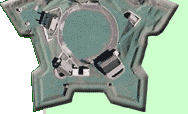
 |
 |
Fort Caroline Jacksonville, Florida |
 |
 |
 |
 |
 |
||
 |
French Huguenots, inspired by the writings of John Calvin (1509-1564) to be the target of mass persecution in the mid-16th century,
found themselves in need of a new home, where Catholics wouldn't murder them quite so much. One group of Huguenots, led by Rene Goulaine de Laudonniere (1529-1574),
landed at what is now Jacksonville Florida and founded the colony of Fort Caroline on June 22 1564. The fort and colony were named for French King Charles IX (1550-1574),
who would go on to watch, horrified, as thousands of Huguenots were killed during the St. Bartholemew's Day Massacre in 1572: Although he did little to stop the massacre,
he would die two years later in a somewhat crazed state, hearing the screams of the dying ringing in his ears. You'll perhaps note that Charles' name was not Caroline, nor was his wife's, nor his mother's. In this case, "Caroline" translates from Old French as "land belonging to Charles." Seriously. Jean Ribault (1520-1565) was the French explorer who first found the spot where Fort Caroline would be built, and returned with ships and troops in June of 1565. Spain, however, had sent its own force to Florida led by Don Pedro Menendez de Aviles, bent on eliminating all whiffs of Frenchness from the New World. Spain saw the Huguenots as not ONLY competitors in the New World, but also heretics and, well, French. The opposing fleets met off Florida shortly after Ribault arrived. After briefly bashing on one another, the Spanish disengaged and sailed about 35 miles down the Florida coast, landing at St. Augustine, which they founded as a Spanish settlement. Ribault pursued the Spanish but was caught up in a storm at sea, which kept him occupied for several days as Menendez sent 500 troops overland to Fort Caroline, where they surprised the garrison with a dawn attack: Of the 250 or so Huguenots, only 50 women and children survived - as did Laudonniere, who had escaped to scamper free in the wilderness. No, actually he and the survivors made it to England on November 15. Ribault's ships were driven ashore and so badly battered by the storm that he had little choice but to surrender to Menendez' land force, heading back to St. Augustine after a good day's work at Fort Caroline. The surviving French were massacred at what is now known as Matanzas ("massacres") Inlet. Thus ended France's attempts to colonize Florida. More about St. Augustine and the truly awesome star fort there, the Castillo de San Marcos, can be read at our related page. Never ones to take such an insult lightly, be those insulted Huguenots or not, the French sent Dominique de Gourgue (1530-1593) to Florida in April of 1568 for revenge. Gourge's force attacked and destroyed the fort that the Spanish had built to replace Fort Caroline and slaughtered everyone they found there. The Spanish returned in 1569 and rebuilt the fort yet again, but abandoned it shortly thereafter. Fort Caroline was named a National Memorial in 1950. A scaled-down reconstruction of the original fort was built, and today is visitable as part of the Timucuan Ecological and Historic Preserve, which includes the Theodore Roosevelt (1858-1919) Area...named for the US' 25th President, William McKinley (1843-1901). |
 |
 |
||
|
|
|||||||
Info Source 1
Info Source 2
Info Source 3
Info Source 4
Info Source 5 Info Source 6 Info Source 7 Info Source 8 Info Source 9 Info Source 10 Info Source 11 Info Source 12 Info Source 13 Info Source 14 Info Source 15 Thanks to Google Maps for the image! ©2010 starforts.com |
 |